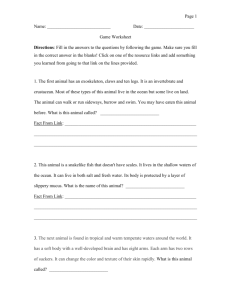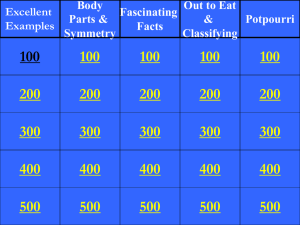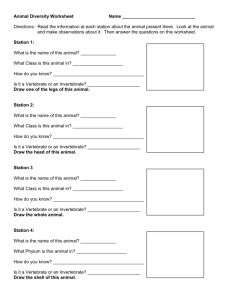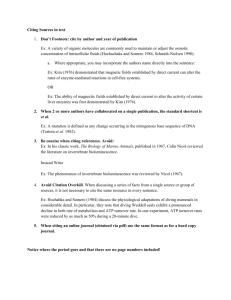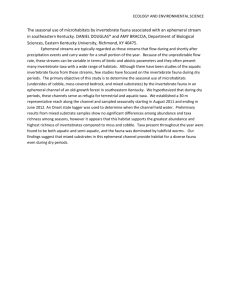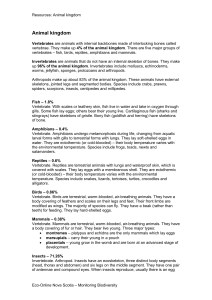Plant Diversity and Invertebrate Diversity L2
advertisement
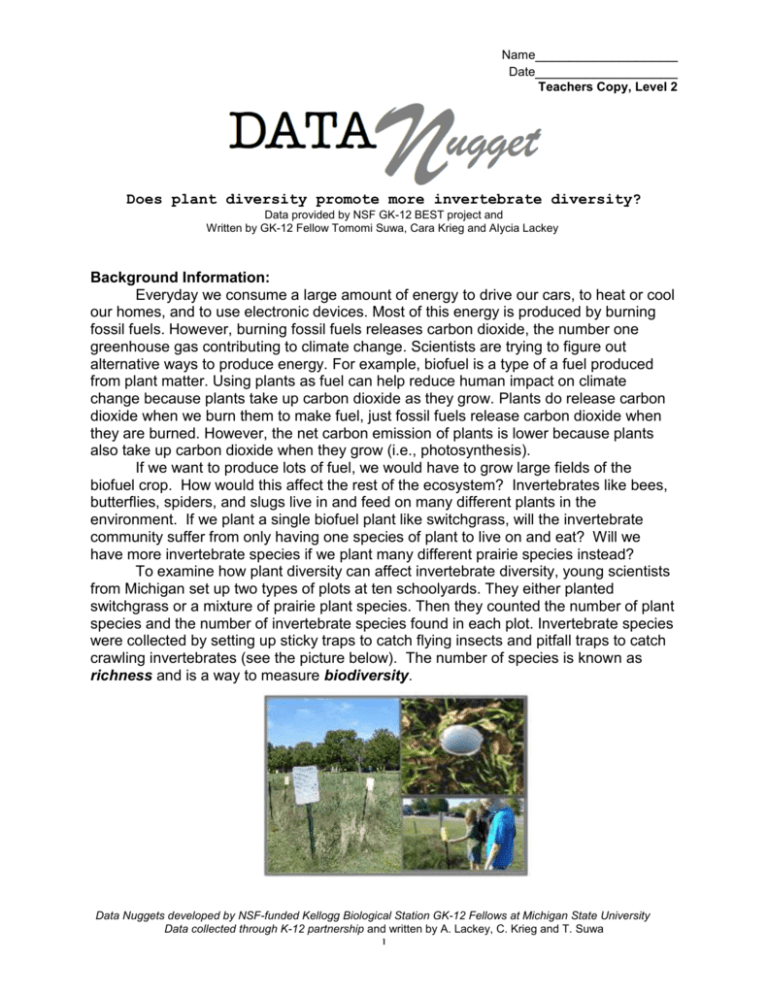
Name_________________ Date_________________ Teachers Copy, Level 2 Does plant diversity promote more invertebrate diversity? Data provided by NSF GK-12 BEST project and Written by GK-12 Fellow Tomomi Suwa, Cara Krieg and Alycia Lackey Background Information: Everyday we consume a large amount of energy to drive our cars, to heat or cool our homes, and to use electronic devices. Most of this energy is produced by burning fossil fuels. However, burning fossil fuels releases carbon dioxide, the number one greenhouse gas contributing to climate change. Scientists are trying to figure out alternative ways to produce energy. For example, biofuel is a type of a fuel produced from plant matter. Using plants as fuel can help reduce human impact on climate change because plants take up carbon dioxide as they grow. Plants do release carbon dioxide when we burn them to make fuel, just fossil fuels release carbon dioxide when they are burned. However, the net carbon emission of plants is lower because plants also take up carbon dioxide when they grow (i.e., photosynthesis). If we want to produce lots of fuel, we would have to grow large fields of the biofuel crop. How would this affect the rest of the ecosystem? Invertebrates like bees, butterflies, spiders, and slugs live in and feed on many different plants in the environment. If we plant a single biofuel plant like switchgrass, will the invertebrate community suffer from only having one species of plant to live on and eat? Will we have more invertebrate species if we plant many different prairie species instead? To examine how plant diversity can affect invertebrate diversity, young scientists from Michigan set up two types of plots at ten schoolyards. They either planted switchgrass or a mixture of prairie plant species. Then they counted the number of plant species and the number of invertebrate species found in each plot. Invertebrate species were collected by setting up sticky traps to catch flying insects and pitfall traps to catch crawling invertebrates (see the picture below). The number of species is known as richness and is a way to measure biodiversity. Data Nuggets developed by NSF-funded Kellogg Biological Station GK-12 Fellows at Michigan State University Data collected through K-12 partnership and written by A. Lackey, C. Krieg and T. Suwa 1 Name_________________ Date_________________ Teachers Copy, Level 2 Scientific Question: How does plant diversity affect invertebrate diversity? (A) What is your prediction? Why do you predict this? If greater invertebrate diversity increases with greater plant diversity, then plots with higher number of plant species will have greater invertebrate diversity. //OR// I predict that invertebrate diversity will increase as plant diversity increases. (B) Look at the data below. Do you see any patterns related to your prediction? Note: we measured invertebrate diversity by measuring two things: (1) the number of invertebrate orders and (2) the number of invertebrate individuals. School Comstock Delton1 Delton2 Delton 3 Gobles 1 Gobles 2 Gull Lake 1 Gull Lake 2 Harper Creek1 Lawton 1 Lawton 2 Parchment1 Parchment2 Plainwell1 Plainwell2 Plainwell3 Number of Plant species 10.7 3.5 4.9 4.8 4.6 2.6 3.8 4.9 5.0 4.4 5.3 3.9 5.1 4.3 8.5 4.4 Number of Invertebrate Orders Number of Invertebrate Individuals 4.4 6.5 7.6 7.4 2.9 2.3 7.0 5.8 7.4 8.6 5.6 5.3 6.0 8.5 6.0 5.3 205.6 48.8 51.8 66.6 18.9 42.3 115.9 95.5 52.3 116.5 112.1 174.5 260.0 147.8 91.3 93.8 Data Nuggets developed by NSF-funded Kellogg Biological Station GK-12 Fellows at Michigan State University Data collected through K-12 partnership and written by A. Lackey, C. Krieg and T. Suwa 2 Name_________________ Date_________________ Teachers Copy, Level 2 (C) What parts of the data will you use to answer the question? Graph 1: Identify independent and dependent variables. Independent (what did we set up?): # of plant species (plant richness)__ Dependent variable (what did we measure?): _ # invertebrate orders (invertebrate richness) Circle numbers you will plot on Graph 1 with a solid circle. Graph 2: Identify independent and dependent variables. Independent (what did we set up?): # of plant species (plant richness)__ Dependent variable (what did we measure?): # invertebrate abundance (invertebrate abundance) Circle numbers you will plot on Graph 2 with a dashed circle. (D) Use the data given above collected by scientists to make two graphs. First, make a scatter plot of the relationship between number of plant species and number of invertebrate orders Second, make a scatter plot of the relationship between number of plant species and number of invertebrates. Plot both graphs in separate sheets Data Nuggets developed by NSF-funded Kellogg Biological Station GK-12 Fellows at Michigan State University Data collected through K-12 partnership and written by A. Lackey, C. Krieg and T. Suwa 3 Name_________________ Date_________________ Teachers Copy, Level 2 (E) Claim: Using the information from your graph, write a statement that answers the scientific question: “How does plant diversity (richness) affect invertebrate diversity? ” Number of plant species v. Number of invertebrate orders: There’s no relationship between two variables. Plant diversity (number of plant species in this case) has no effect on number of invertebrate orders. Number of plant species vs. Number of invertebrates: There is a positive relationship between these variables, indicating that number of plant species increases number of invertebrate orders. (F) Evidence: Using the information from your graph, write a statement that answers the scientific question. The relationship between number of plant species and number of invertebrate orders is flat (R2 = 0.006), whereas number of plant species had positive effects on number of invertebrates (R2 = 0.188). Note: if students do not use excel to obtain an R2 value, they should still be able to observe these basic patterns by sketching a best-fit line. (G) Reasoning: How does the data in your graph support your statement? Draw arrows and/or circle the parts of the graph that you used to make your statement. Data Nuggets developed by NSF-funded Kellogg Biological Station GK-12 Fellows at Michigan State University Data collected through K-12 partnership and written by A. Lackey, C. Krieg and T. Suwa 4 Name_________________ Date_________________ Teachers Copy, Level 2 If Plant diversity affects invertebrate diversity, the slopes of the graphs would be significantly positive or negative. However, we find mixed results. . Plant diversity does not impact invertebrate diversity in these plots. Plots with more plant diversity tend to have a greater number of insects, but this larger insect community is not more diverse. Data Nuggets developed by NSF-funded Kellogg Biological Station GK-12 Fellows at Michigan State University Data collected through K-12 partnership and written by A. Lackey, C. Krieg and T. Suwa 5
